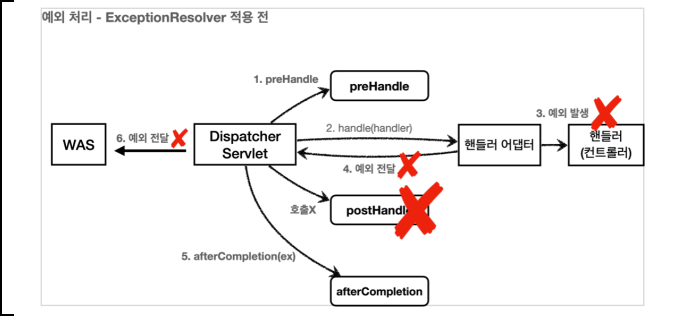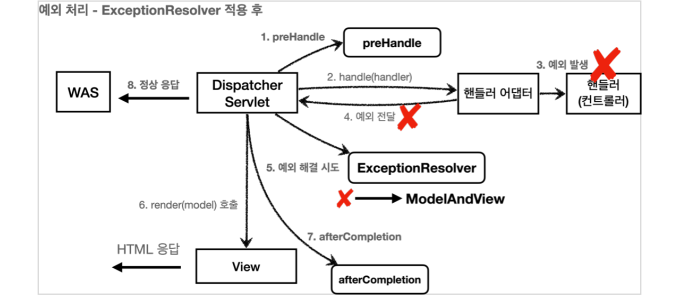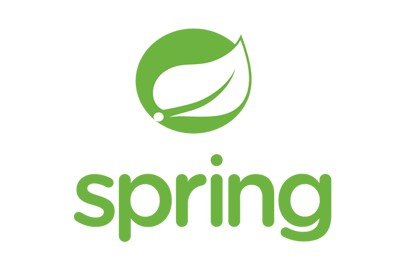- Spring mvc2 타임리프 기본기능
- Spring mvc2 타임리프 스프링 통합과 폼
- Spring mvc2(2) 메세지, 국제화
- Spring mvc2(3) 검증1 validation
- Spring mvc2 검증2 1 bean validation
- Spring mvc2 검증2 2 로그인 처리1 쿠키, 세션
- Spring mvc2 검증2 3 로그인 처리2 필터, 인터셉터
- Spring mvc2 검증2 4 예외 처리와 오류 페이지
- Spring mvc2(1) api 예외처리
- Spring mvc2(2) 스프링 타입 컨버터
- Spring mvc2(3) 파일 업로드
Spring mvc2(1) api 예외처리
1. API 예외 처리 - 시작
API 예외 처리는 어떻게 해야할까?
- API의 경우에는 생각할 내용이 더 많다. 오류 페이지는 단순히 고객에게 오류 화면을 보여주고 끝이지만, API는 각 오류 상황에 맞는 오류 응답 스펙을 정하고, JSON으로 데이터를 내려주어야 한다.\
- API도 오류 페이지에서 설명했던 것 처럼 처음으로 돌아가서 서블릿 오류 페이지 방식을 사용해보자.
WebServerCustomizer 다시 동작
-
@Component 주석을 풀고 다시 동작시킨다.
-
package hello.exception; import org.springframework.boot.web.server.ConfigurableWebServerFactory; import org.springframework.boot.web.server.ErrorPage; import org.springframework.boot.web.server.WebServerFactoryCustomizer; import org.springframework.http.HttpStatus; import org.springframework.stereotype.Component; @Component public class WebServerCustomizer implements WebServerFactoryCustomizer<ConfigurableWebServerFactory> { @Override public void customize(ConfigurableWebServerFactory factory) { //WAS 까지 오류값이 넘어와서 다시 여기서 path 로 넘김 ErrorPage errorPage404 = new ErrorPage(HttpStatus.NOT_FOUND, "/error-page/404"); ErrorPage errorPage500 = new ErrorPage(HttpStatus.INTERNAL_SERVER_ERROR, "/error-page/500"); //RuntimeException 자식타입까지 예외처리 ErrorPage errorPageEx = new ErrorPage(RuntimeException.class, "/error-page/500"); factory.addErrorPages(errorPage404, errorPage500, errorPageEx); } }
ApiExceptionController - API 예외 컨트롤러
-
package hello.exception.api; import lombok.AllArgsConstructor; import lombok.Data; import lombok.extern.slf4j.Slf4j; import org.springframework.beans.factory.annotation.Autowired; import org.springframework.web.bind.annotation.GetMapping; import org.springframework.web.bind.annotation.PathVariable; import org.springframework.web.bind.annotation.RestController; @Slf4j @RestController public class ApiExceptionController { @GetMapping("/api/members/{id}") public MemberDto getMember(@PathVariable("id") String id) { if (id.equals("ex")) { throw new RuntimeException("잘못된 사용자"); } return new MemberDto(id, "hello " + id); } @Data @AllArgsConstructor static class MemberDto { private String memberId; private String name; } }- 단순히 회원을 조회하는 기능을 하나 만들었다. 예외 테스트를 위해 URL에 전달된 id 의 값이 ex 이면 예외가 발생하도록 코드를 심어두었다.
Postman으로 테스트
HTTP Header에 Accept 가 application/json 인 것을 꼭 확인하자.
정상 호출
-
http://localhost:8080/api/members/Spring -
{ "memberId": "spring", "name": "hello spring" }
예외 발생 호출
http://localhost:8080/api/members/ex- 미리 만들어둔 오류 페이지 HTML이 반환된다. -> 기대하는 바가 아니다.
- 클라이언트는 정상 요청이든, 오류 요청이든 JSON이 반환되기를 기대한다. 웹 브라우저가 아닌 이상 HTML을 직접 받아서 할 수 있는 것은 별로 없다.
문제를 해결하려면 오류 페이지 컨트롤러도 JSON 응답을 할 수 있도록 수정해야 한다.
ErrorPageController - API 응답 추가
-
@RequestMapping(value = "/error-page/500", produces = MediaType.APPLICATION_JSON_VALUE) public ResponseEntity<Map<String, Object>> errorPage500Api( HttpServletRequest request, HttpServletResponse response){ log.info("API errorPage 500"); Map<String, Object> result = new HashMap<>(); Exception ex = (Exception) request.getAttribute(ERROR_EXCEPTION); result.put("status", request.getAttribute(ERROR_STATUS_CODE)); //ex.getMessage() ==> RuntimeException 이 발생했을 때 메세지"잘못된 사용자"를 반환(ApiExceptionController 에서 설정함) result.put("message", ex.getMessage()); Integer statusCode = (Integer) request.getAttribute(RequestDispatcher.ERROR_STATUS_CODE); return new ResponseEntity<>(result, HttpStatus.valueOf(statusCode)); }-
@RequestMapping 의
produces = MediaType.APPLICATION_JSON_VALUE의 뜻은 클라이언트가 요청하는 HTTP Header의 Accept 의 값이 application/json 일 때 해당 메서드가 호출된다는 것이다.-> 결국 클라어인트가 받고 싶은 미디어타입이 json이면 이 컨트롤러의 메서드가 호출된다.
-
-
응답 데이터를 위해서 Map 을 만들고 status , message 키에 값을 할당했다. Jackson 라이브러리는 Map 을 JSON 구조로 변환할 수 있다.
- ResponseEntity 를 사용해서 응답하기 때문에 메시지 컨버터가 동작하면서 클라이언트에 JSON이 반환된다.
ResponseEntity (이게 뭐야)
-
public class ResponseEntity<T> extends HttpEntity<T> { private final Object status; /** * Create a {@code ResponseEntity} with a body and status code. * @param body the entity body * @param status the status code */ public ResponseEntity(@Nullable T body, HttpStatusCode status) { this(body, null, status); -
클래스 형태는
ResponseEntity<T>이다. 제너럴 타입인데, 여기서는 Map<String, Object> 를 넣어줬다.- Jackson 라이브러리가 Map 을 JSON 구조로 변환할 수 있기 때문이다.
-
그리고 생성자를 이렇게 쓰고 반환해준다.
public ResponseEntity(@Nullable T body, HttpStatusCode status)
ex.getMessage() 가 아니라 (String) request.getAttribute(ERROR_MESSAGE); 으로 바로 하면 안되나??
-
String ex1 = (String) request.getAttribute(ERROR_MESSAGE);으로 했을 때 출력 값이-
{ "message": "Request processing failed: java.lang.RuntimeException: 잘못된 사용자", "status": 500 }
-
-
이렇게 찍힌다.
-
그럼 ex.getMessage() 는 왜 이렇게 안찍히냐?
-
Exception 은 Throwable 을 상속받는데, getMessage() 는 String detailMessage 만 반환한다.
-
그럼
request.getAttribute(ERROR_MESSAGE)는 왜 저렇게 찍히냐?- 아직 못찾아봄 ㅎ
포스트맨을 통해서 다시 테스트
-
HTTP Header에 Accept 가 application/json 인 것을 꼭 확인하자.
-
http://localhost:8080/api/members/ex -
{ "message": "잘못된 사용자", "status": 500 }
2. API 예외 처리 - 스프링 부트 기본 오류 처리
- API 예외 처리도 스프링 부트가 제공하는 기본 오류 방식(BasicErrorController)을 사용할 수 있다.
BasicErrorController 코드
-
@RequestMapping(produces = MediaType.TEXT_HTML_VALUE) public ModelAndView errorHtml(HttpServletRequest request, HttpServletResponse response) {} @RequestMapping public ResponseEntity<Map<String, Object>> error(HttpServletRequest request) {}- /error 동일한 경로를 처리하는 errorHtml() , error() 두 메서드를 확인할 수 있다.
-
errorHtml() : produces = MediaType.TEXT_HTML_VALUE : 클라이언트 요청의 Accept 해더 값이 text/html 인 경우에는 errorHtml() 을 호출해서 view를 제공한다.
- error() : 그외 경우에 호출되고 ResponseEntity 로 HTTP Body에 JSON 데이터를 반환한다.
즉, Accept 해더 값이 text/html 인 경우 제외하고 모두 JSON 데이터로 반환
Postman으로 실행 (WebServerCustomizer 는 주석처)
-
GET
http://localhost:8080/api/members/ex -
body 값
-
{ "timestamp": "2021-04-28T00:00:00.000+00:00", "status": 500, "error": "Internal Server Error", "exception": "java.lang.RuntimeException", "trace": "java.lang.RuntimeException: 잘못된 사용자\n\tat hello.exception.web.api.ApiExceptionController.getMember(ApiExceptionController .java:19..., "message": "잘못된 사용자", "path": "/api/members/ex" }- 다음 옵션들을 설정하면 더 자세한 오류 정보를 추가할 수 있다.
- server.error.include-binding-errors=always
- server.error.include-exception=true
- server.error.include-message=always
- server.error.include-stacktrace=always
- 물론 오류 메시지는 이렇게 막 추가하면 보안상 위험할 수 있다. 간결한 메시지만 노출하고, 로그를 통해서 확인하자.
- 다음 옵션들을 설정하면 더 자세한 오류 정보를 추가할 수 있다.
Html 페이지 vs API 오류
- BasicErrorController 를 확장하면 JSON 메시지도 변경할 수 있다. 그런데 API 오류는 조금 뒤에 설명할 @ExceptionHandler 가 제공하는 기능을 사용하는 것이 더 나은 방법이다.
- 스프링 부트가 제공하는 BasicErrorController 는 HTML 페이지를 제공하는 경우에는 매우 편리하다. 4xx, 5xx 등등 모두 잘 처리해준다.
- 그런데 API 오류 처리는 다른 차원의 이야기이다. API 마다, 각각의 컨트롤러나 예외마다 서로 다른 응답 결과를 출력해야 할 수도 있다. 예를 들어서 회원과 관련된 API에서 예외가 발생할 때 응답과, 상품과 관련된 API에서 발생하는 예외에 따라 그 결과가 달라질 수 있다. 결과적으로 매우 세밀하고 복잡하다.
따라서 이 방법은 HTML 화면을 처리할 때 사용하고, API 오류 처리는 뒤에서 설명할 @ExceptionHandler 를 사용하자.
3. API 예외 처리 - HandlerExceptionResolver 시작
- 예외가 발생해서 서블릿을 넘어 WAS까지 예외가 전달되면 HTTP 상태코드가 500으로 처리된다.
- 하지만, 발생하는 예외에 따라서 400, 404 등등 다른 상태코드로 처리하고 싶다.
- 오류 메시지, 형식등을 API마다 다르게 처리하고 싶다.
상태코드 변환
- 예를 들어서 IllegalArgumentException 을 처리하지 못해서 컨트롤러 밖으로 넘어가는 일이 발생하면 HTTP 상태코드를 400으로 처리하고 싶다.
ApiExceptionController - 수정
-
package hello.exception.api; import ...; @Slf4j @RestController public class ApiExceptionController { @GetMapping("/api/members/{id}") public MemberDto getMember(@PathVariable("id") String id) { if (id.equals("ex")) { throw new RuntimeException("잘못된 사용자"); } if (id.equals("bad")) { throw new IllegalArgumentException("잘못 입력된 값"); } return new MemberDto(id, "hello " + id); } }http://localhost:8080/api/members/bad라고 호출하면 IllegalArgumentException 이 발생하도록 했다.
실행해보면 상태 코드가 500인 것을 확인할 수 있다.
{
"status": 500,
"error": "Internal Server Error",
"exception": "java.lang.IllegalArgumentException",
"path": "/api/members/bad"
}
-> 서버에서 발생한 에러이기 때문이다!
HandlerExceptionResolver
- 스프링 MVC는 컨트롤러(핸들러) 밖으로 예외가 던져진 경우 예외를 해결하고, 동작을 새로 정의할 수 있는 방법을 제공한다.
- 컨트롤러 밖으로 던져진 예외를 해결하고, 동작 방식을 변경하고 싶으면 HandlerExceptionResolver 를 사용하면 된다. 줄여서 ExceptionResolver 라 한다.
ExceptionResolver 적용 전
http://localhost:8080/api/members/bad호출- 예외 발생 : IllegalArgumentException
- WAS 에서는 서버 측에서 예외가 발생했다고 res 를 받으면, 500 에러를 터트리게 된다
ExceptionResolver 적용 후
http://localhost:8080/api/members/bad호출- 예외 발생 : IllegalArgumentException
- ExceptionResolver 에서 예외 해결 시도 -> 가능 시 res.sendError 로 에러값을 담아주고 ModelAndView 반환
- ModelAndView 와 함께 sendError 를 BasicErrorController 로 해결 (Json) 타입으로 응답
HandlerExceptionResolver - 인터페이스
-
public interface HandlerExceptionResolver { ModelAndView resolveException( HttpServletRequest request, HttpServletResponse response, Object handler, Exception ex); }- handler : 핸들러(컨트롤러) 정보
- Exception ex : 핸들러(컨트롤러)에서 발생한 발생한 예외
MyHandlerExceptionResolver
-
package hello.exception.resolver; import jakarta.servlet.http.HttpServletRequest; import jakarta.servlet.http.HttpServletResponse; import lombok.extern.slf4j.Slf4j; import org.springframework.web.servlet.HandlerExceptionResolver; import org.springframework.web.servlet.ModelAndView; import java.io.IOException; @Slf4j public class MyHandlerExceptionResolver implements HandlerExceptionResolver { @Override public ModelAndView resolveException(HttpServletRequest request, HttpServletResponse response, Object handler, Exception ex) { log.info("IllegalArgumentException resolver to 400"); try { if(ex instanceof IllegalArgumentException){ response.sendError(HttpServletResponse.SC_BAD_REQUEST, ex.getMessage()); //예외는 먹어버리고 정상 return return new ModelAndView(); } } catch (IOException e) { log.error("resolver ex", e); } return null; } }- ExceptionResolver 가 ModelAndView 를 반환하는 이유는 마치 try, catch를 하듯이, Exception 을 처리해서 정상 흐름 처럼 변경하는 것이 목적이다. 이름 그대로 Exception 을 Resolver(해결)하는 것이 목적이다.
- 여기서는 IllegalArgumentException 이 발생하면 response.sendError(400) 를 호출해서 HTTP 상태 코드를 400으로 지정하고, 빈 ModelAndView 를 반환한다.
반환 값에 따른 동작 방식
- 빈 ModelAndView : new ModelAndView() 처럼 빈 ModelAndView 를 반환하면 뷰를 렌더링 하지 않고, 정상 흐름으로 서블릿이 리턴된다.
- ModelAndView 지정: ModelAndView 에 View , Model 등의 정보를 지정해서 반환하면 뷰를 렌더링 한다.
- null: null 을 반환하면, 다음 ExceptionResolver 를 찾아서 실행한다. 만약 처리할 수 있는 ExceptionResolver 가 없으면 예외 처리가 안되고, 기존에 발생한 예외를 서블릿 밖으로 던진다.
ExceptionResolver 활용
- 예외 상태 코드 변환
- 예외를 response.sendError(xxx) 호출로 변경해서 서블릿에서 상태 코드에 따른 오류를 처리하도록 위임
- 이후 WAS는 서블릿 오류 페이지를 찾아서 내부 호출, 예를 들어서 스프링 부트가 기본으로 설정한 /error 가 호출됨
- 뷰 템플릿 처리
ModelAndView에 값을 채워서 예외에 따른 새로운 오류 화면 뷰 렌더링 해서 고객에게 제공
- API 응답 처리
response.getWriter().println("hello");처럼 HTTP 응답 바디에 직접 데이터를 넣어주는 것도 가능하다. 여기에 JSON 으로 응답하면 API 응답 처리를 할 수 있다.
WebConfig - 수정
-
@Override public void extendHandlerExceptionResolvers(List<HandlerExceptionResolver> resolvers) { resolvers.add(new MyHandlerExceptionResolver()); }
4. API 예외 처리 - HandlerExceptionResolver 활용 (WAS 까지 에러넘기지 않기)
예외를 여기서 마무리하기
- 예외가 발생하면 WAS까지 예외가 던져지고, WAS에서 오류 페이지 정보를 찾아서 다시 /error 를 호출하는 과정은 생각해보면 너무 복잡하다.
- ExceptionResolver 를 활용하면 예외가 발생했을 때 이런 복잡한 과정 없이 여기에서 문제를 깔끔하게 해결할 수 있다.
UserException(사용자 정의 예외)
-
package hello.exception.exception; public class UserException extends RuntimeException { public UserException() { super(); } public UserException(String message) { super(message); } public UserException(String message, Throwable cause) { super(message, cause); } public UserException(Throwable cause) { super(cause); } protected UserException(String message, Throwable cause, boolean enableSuppression, boolean writableStackTrace) { super(message, cause, enableSuppression, writableStackTrace); } }
ApiExceptionController - 예외 추가
-
http://localhost:8080/api/members/user-ex호출시 UserException 이 발생하도록 해두었다 -
package hello.exception.api; import hello.exception.exception.UserException; import lombok.AllArgsConstructor; import lombok.Data; import lombok.extern.slf4j.Slf4j; import org.springframework.beans.factory.annotation.Autowired; import org.springframework.web.bind.annotation.GetMapping; import org.springframework.web.bind.annotation.PathVariable; import org.springframework.web.bind.annotation.RestController; @Slf4j @RestController public class ApiExceptionController { @GetMapping("/api/members/{id}") public MemberDto getMember(@PathVariable("id") String id) { if (id.equals("ex")) { throw new RuntimeException("잘못된 사용자"); } if (id.equals("bad")) { throw new IllegalArgumentException("잘못 입력된 값"); } if (id.equals("user-ex")) { throw new UserException("사용자 오류"); } return new MemberDto(id, "hello " + id); } }
UserHandlerExceptionResolver
-
주석 참
-
package hello.exception.resolver; @Slf4j public class UserHandlerExceptionResolver implements HandlerExceptionResolver { private final ObjectMapper objectMapper = new ObjectMapper(); @Override public ModelAndView resolveException(HttpServletRequest request, HttpServletResponse response, Object handler, Exception ex) { try { //만약 exception 이 UserException 이면 if(ex instanceof UserException){ log.info("UserException resolver to 400"); //"accept" 헤더값 저장 String acceptHeader = request.getHeader("accept"); //400 에러 res 에 넘김 response.setStatus(HttpServletResponse.SC_BAD_REQUEST); //만약 accept 헤더가 application/json 이면 if ("application/json".equals(acceptHeader)) { Map<String, Object> errorResult = new HashMap<>(); //exception 값을 Map 에 넣어서 json 값으로 변경한 다음에 errorResult.put("ex", ex.getClass()); errorResult.put("message", ex.getMessage()); String result = objectMapper.writeValueAsString(errorResult); //contentType, encoding 값 넘겨주고 response.setContentType("application/json"); response.setCharacterEncoding("utf-8"); //res 에 result 넘겨서 정상 호출처럼 동작하게 함 response.getWriter().write(result); return new ModelAndView(); }else{ // acceptHeader 가 TEXT/HTML 이면 ModelAndView 로 html 호출 return new ModelAndView("error/500"); } } } catch (IOException e) { log.error("resolver ex", e); } return null; } }
WebConfig에 UserHandlerExceptionResolver 추가
-
@Override public void extendHandlerExceptionResolvers(List<HandlerExceptionResolver> resolvers) { resolvers.add(new MyHandlerExceptionResolver()); resolvers.add(new UserHandlerExceptionResolver()); }
실행 / 정리
-
POSTMAN 실행 :
http://localhost:8080/api/members/user-ex -
{ "ex": "hello.exception.exception.UserException", "message": "사용자 오류" } - ExceptionResolver 를 사용하면 컨트롤러에서 예외가 발생해도 ExceptionResolver 에서 예외를 처리해버린다.
- 따라서 예외가 발생해도 서블릿 컨테이너까지 예외가 전달되지 않고, 스프링 MVC에서 예외 처리는 끝이 난다.
결과적으로 WAS 입장에서는 정상 처리가 된 것이다. 이렇게 예외를 이곳에서 모두 처리할 수 있다는 것이 핵심이다.
서블릿 컨테이너까지 예외가 올라가면 복잡하고 지저분하게 추가 프로세스가 실행된다. 반면에 ExceptionResolver 를 사용하면 예외처리가 상당히 깔끔해진다.
5. API 예외 처리 - 스프링이 제공하는 ExceptionResolver1
스프링 부트가 기본으로 제공하는 ExceptionResolver 는 다음과 같다.
- HandlerExceptionResolverComposite 에 다음 순서로 등록
- ExceptionHandlerExceptionResolver : @ExceptionHandler 을 처리한다.
- ResponseStatusExceptionResolver : HTTP 상태 코드를 지정해준다.
- 예) @ResponseStatus(value = HttpStatus.NOT_FOUND
- DefaultHandlerExceptionResolver : 스프링 내부 기본 예외를 처리한다.
ResponseStatusExceptionResolver
ResponseStatusExceptionResolver 는 예외에 따라서 HTTP 상태 코드를 지정해주는 역할을 한다.
다음 두 가지 경우를 처리한다.
- @ResponseStatus 가 달려있는 예외
- ResponseStatusException 예외
@ResponseStatus 적용
-
다음과 같이 @ResponseStatus 애노테이션을 적용하면 HTTP 상태 코드를 변경해준다. (400 error)
-
package hello.exception.exception; import org.springframework.http.HttpStatus; import org.springframework.web.bind.annotation.ResponseStatus; @ResponseStatus(code = HttpStatus.NOT_FOUND, reason = "잘못된 요청 오류") public class BadRequestException extends RuntimeException{ }
ApiExceptionController - 추가
-
@GetMapping("/api/response-status-ex1") public String responseStatusEx1() { throw new BadRequestException(); }
실행
http://localhost:8080/api/response-status-ex1
-
{ "status": 400, "error": "Bad Request", "exception": "hello.exception.exception.BadRequestException", "message": "잘못된 요청 오류", "path": "/api/response-status-ex1" }
메시지 기능
-
@ResponseStatus 의 reason 속성은 reason 을 MessageSource 에서 찾는 기능도 제공한다.
- reason = “error.bad” (
@ResponseStatus(code = HttpStatus.NOT_FOUND, reason = "error.bad"))
- reason = “error.bad” (
-
messages.properties->error.bad=잘못된 요청 오류입니다. 메시지 사용 -
{ "status": 400, "error": "Bad Request", "exception": "hello.exception.exception.BadRequestException", "message": "잘못된 요청 오류입니다. 메시지 사용", "path": "/api/response-status-ex1" }
ResponseStatusException
- @ResponseStatus 는 개발자가 직접 변경할 수 없는 예외에는 적용할 수 없다. (애노테이션을 직접 넣어야 하는데, 내가 코드를 수정할 수 없는 라이브러리의 예외 코드 같은 곳에는 적용할 수 없다.)
- 추가로 애노테이션을 사용하기 때문에 조건에 따라 동적으로 변경하는 것도 어렵다.
이때는 ResponseStatusException 예외를 사용하면 된다.
ApiExceptionController - 추가
-
@GetMapping("/api/response-status-ex2") public String responseStatusEx2() { throw new ResponseStatusException(HttpStatus.NOT_FOUND, "error.bad", new IllegalArgumentException()); }
결과
-
http://localhost:8080/api/response-status-ex2 -
{ "status": 404, "error": "Not Found", "exception": "org.springframework.web.server.ResponseStatusException", "message": "잘못된 요청 오류입니다. 메시지 사용", "path": "/api/response-status-ex2" }
6. API 예외 처리 - 스프링이 제공하는 ExceptionResolver2 (DefaultHandlerExceptionResolver)
- DefaultHandlerExceptionResolver 는 스프링 내부에서 발생하는 스프링 예외를 해결한다.
- 대표적으로 파라미터 바인딩 시점에 타입이 맞지 않으면 내부에서 TypeMismatchException 이 발생하는데, 이 경우 예외가 발생했기 때문에 그냥 두면 서블릿 컨테이너까지 오류가 올라가고, 결과적으로 500 오류가 발생한다.
- 그런데 파라미터 바인딩은 대부분 클라이언트가 HTTP 요청 정보를 잘못 호출해서 발생하는 문제이다. HTTP 에서는 이런 경우 HTTP 상태 코드 400을 사용하도록 되어 있다.
- DefaultHandlerExceptionResolver 는 이것을 500 오류가 아니라 HTTP 상태 코드 400 오류로 변경한다.
코드 확인
-
DefaultHandlerExceptionResolver.handleTypeMismatch 를 보면 다음과 같은 코드를 확인할 수 있다.
-
protected ModelAndView handleTypeMismatch(TypeMismatchException ex, HttpServletRequest request, HttpServletResponse response, @Nullable Object handler) throws IOException { response.sendError(HttpServletResponse.SC_BAD_REQUEST); return new ModelAndView(); } - 즉, TypeMisMatch 면 response 에 400 을 넣어서 ModelAndView 로 반환한다.
- sendError(400) 를 호출했기 때문에 WAS에서 다시 오류 페이지( /error )를 내부 요청한다.
ApiExceptionController - 추가
-
@GetMapping("/api/default-handler-ex") public String defaultException(@RequestParam Integer data) { return "ok"; }-
Integer data 에 문자를 입력하면 내부에서
TypeMismatchException이 발생한다. -
실행 :
http://localhost:8080/api/default-handler-ex?data=hello -
{ "status": 400, "error": "Bad Request", "exception": "org.springframework.web.method.annotation.MethodArgumentTypeMismatchException" , "message": "Failed to convert value of type 'java.lang.String' to required type 'java.lang.Integer'; nested exception is java.lang.NumberFormatException: For input string: \"hello\"", "path": "/api/default-handler-ex" }- 실행 결과를 보면 HTTP 상태 코드가 400인 것을 확인할 수 있다.
-
정리
- 지금까지 HTTP 상태 코드를 변경하고, 스프링 내부 예외의 상태코드를 변경하는 기능도 알아보았다.
- 그런데 HandlerExceptionResolver 를 직접 사용하기는 복잡하다. API 오류 응답의 경우 response 에 직접 데이터를 넣어야 해서 매우 불편하고 번거롭다. ModelAndView 를 반환해야 하는 것도 API에는 잘 맞지 않는다.
스프링은 이 문제를 해결하기 위해 @ExceptionHandler 라는 매우 혁신적인 예외 처리 기능을 제공한다.(ExceptionHandlerExceptionResolver)





댓글남기기